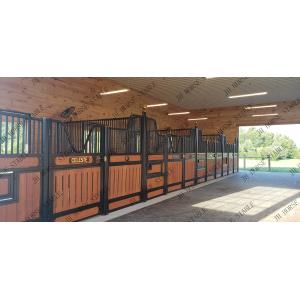
Add to Cart
Horse stalls with a high front style from JH horse stall. They can be dressed up with brass accents, arches, and yokes. Or, they can be designed to have a simple style and an emphasis on function. Everything about JH stall high front stall systems are built to order. That means the size of the steel framing, the overall shape of the stall, and the way they fit in your barn will be exactly what you want
The product details:
| ||||||||||||||||||||||
Aisles or Alleyways
Alleyways between stalls should be at least 10ft wide (3m). The wider the better, so there is room for horses to pass when being led, or be tied to groom.
Flooring
The most commonly used flooring in stables is concrete. If the surface is roughened, it is non-slip. concrete, pavers, or stone floors will not drain naturally, and drains may have to be placed in stalls. Many stables do not have drainage. This means stalls must be well-cleaned to avoid ammonia build up. Hard flooring such as pavers or concrete are also easier to disinfect and can be hosed down if necessary. These floors are harder on a horse's legs though. Many people put stall mats made of rubber like material under the bedding for greater comfort.
If you have sandy soil, you may decide to leave the earth and not lay down a solid floor. This flooring is easier on the horse's legs and may be warmer and quieter than an un-matted solid floor. Earth floors are harder to clean and will need digging out and replacing if the dirt becomes too saturated with urine and water.
Ceilings
Many older barns designed for cattle have low ceilings that are not high enough for horses. Sometimes these barns can be raised, or the floor dug lower if drainage patterns permit. This tends to be a costly procedure. Ceiling height should allow the horse to raise its head comfortably without worrying about hitting the ceiling. A standard room height of 8ft (2.4m) might be fine for ponies and small horses, but taller horses will need higher ceilings. Furthermore, make sure there are no protruding nails from second-story flooring, hanging light fixtures that are unprotected, or other obstructions that horse could hit accidentally when it raises its head.
